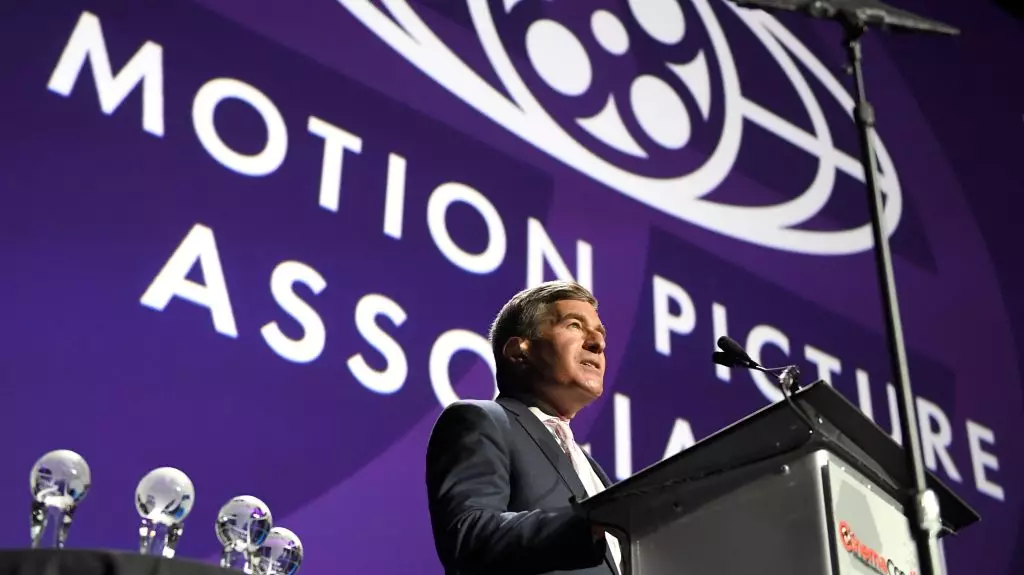In a world where the cinematic landscape is evolving rapidly, Charlie Rivkin, the President and CEO of the Motion Picture Association (MPA), recently addressed attendees at CinemaCon with a message of solidarity and hope. Rivkin’s remarks come at a crucial juncture, where theater owners are wrestling with a tumultuous industry fraught with unpredictability. The fight for theatrical relevance has never felt more urgent, and Rivkin acknowledges this turbulence, pledging that the MPA will continue to stand beside exhibitionists. His words serve as both a reassurance and a rallying cry; the MPA’s mission is clear—to cultivate an environment where great films can flourish in theaters, drawing audiences back to the big screen in droves.
Rivkin emphasized the recent commitment by Amazon MGM Studios to release 12-14 films in theaters next year, a gesture that symbolizes a growing acknowledgment of the importance of theatrical distribution. It is a vital statistic in a year where studios must reconsider the hurried shift towards direct-to-consumer platforms. Rivkin’s recognition of a collective anxiety among theater owners speaks volumes; the industry is not just recovering from the pandemic but is also navigating the fallout from shifting audience behaviors.
The Call for Restored Practices
The exhibition industry stands as a volatile entity, with both opportunities and threats intertwined. Rivkin’s insights push for a new dialogue about the current strategies that studios employ, many of which were adopted during the COVID-19 pandemic. It is evident that streamlining release strategies will be critical for theater owners who want to provide a diversified slate of films that engage audiences. As cinema-goers increasingly demand experiences that resonate with their emotions, the importance of theatrical release cannot be overstated. Rivkin argues that returning to traditional methods of supporting theatrical releases is not only necessary but essential for survival.
The MPA’s role as the leading voice for the motion picture industry worldwide becomes particularly relevant in this context. Rivkin articulated the continuous need to work actively with policymakers—making a cogent case for the financial significance of film production. Understanding that each theatrical release impacts local communities economically should spur broader public support for cinema. The MPA’s objective is two-fold: ensuring that filmmakers have the incentives they need to produce content and that theater owners gain access to films that reflect those productions.
Revitalizing Local Economies Through Film Production
One of Rivkin’s compelling arguments revolves around the economic boon that film production brings to local communities. On average, each major motion picture generates an astonishing $1.3 million in daily economic activity during production. With nearly 1,600 local hires involved, the impact is immense—not just in terms of job creation but also in the significant wages that exceed national averages by a notable margin. Rivkin painted a vivid picture of how film production not only brings jobs but also revitalizes local businesses and generates consumer spending—key components in boosting the health of community economies.
As Rivkin highlighted California’s new tax incentives, it serves as a crucial reminder of how policy can shape the production landscape. The passage of tax credits for 51 films, set to translate into roughly $580 million in economic activity, exemplifies the kind of momentum that can be achieved through coordinated efforts between industries and government. Rivkin’s emphasis on partnerships with unions and guilds underlines a concerted push for more substantial action at the federal level, advocating for measures that bolster production.
Creating a Collective Future in Cinematic Storytelling
The discussion goes beyond mere statistics; it brings into focus a broader responsibility shared by all stakeholders in the film industry. Rivkin’s perspective urges a collaborative effort—a unified front aimed at ushering in an era of growth and storytelling diversity. By aligning incentives with production needs, industry players can help generate a pipeline of compelling content that speaks to diverse audiences, thereby enriching the theatrical experience.
By championing such grassroots efforts, the MPA is taking steps to articulate a vision that empowers filmmakers and, by extension, theater owners. This concerted approach also has implications for cultural representation on screens, as diverse storytelling can potentially lead to broader audience engagement.
The road ahead requires vigilance, creativity, and partnership—but one thing is crystal clear: the future of cinema rests on a collective commitment to revive and sustain the unique magic of the big screen experience.
